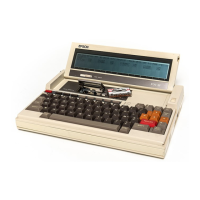REV.-A
2.8.1
Liquid
Crystal
Display
Panel
Structure
The Liquid Crystal Display (LCD)
display
panel is a
480
x
64
dot
matrix
display
panel
which
uses a
twisted
nematic
(TNM)
effect
type
liquid crystal -
one
of
the
voltage
effect
types.
It
is
struc-
tured as
shown
in Fig. 2-75.
Upper polarizer
plate...........
I
~======~~/
~~(====~
~
uppe.r
glass
pia.
te !
L
t
:=:',,'
~~~:~~~::~."=!:t:==~=--::::=::seallng
material
r
~
Liquid crystal
6fz2ZZZl~ZZI/~ZZ/l~Z2ZZI/~ZZI/~Z2ZZ/l~I/Z2Z2ZZIZZ2ZZZZzJ~==~~.Lower
glass plate
-_i~;;;;;;;;;;;;;;;;~~
~ower
polarizer plate
=---l~mmmmm:Z;::Zmii:i:iiilV
Reflector plate
Note:
The polarization angles
of
the
upper
and
lower
polalrizer plates
differ
by
90
degrees.
Oscillation directions
of
light
~--
Polarizer plate
Upper polarizer plate
~1r-l'to.I-----"!~
Light
Polarized by 90°.
(areas where no electric field is applied)
Polarization direction
Dark
(areas where
an
electric field is applied)
Liquid crystal molecule
Lower
glass plate
Upper glass plate
Lower
polarizer plate
Fig.
2-75
2.8.2
Theory
of
Operation
The liquid crystal is
confined
between
the
upper and
lower
glass plates. The upper glass plate has
many
of
electrodes regularly arranged
on
it. The liquid crystal
characteristically
shows
a
twisted
motion,
when
a
voltage
is applied across it,
depending
on
the
magnitude
of
the
voltage
any
the
direction
it
takes
determined
by
the
direction
of
the
applied electric field. Using
of
this
character-
istic
for
the
display
screen,
light
and
dark
contrast
are produced on
the
panel
by
applying
a
vol-
tage across
the
liquid crystal.
To
maintain
this
contrast,
however, a refresh operation
(a
repeated
application
of
voltage) is required simalar
to
the
refresh
system
used
for
the
dynamic
RAM.
2-74

